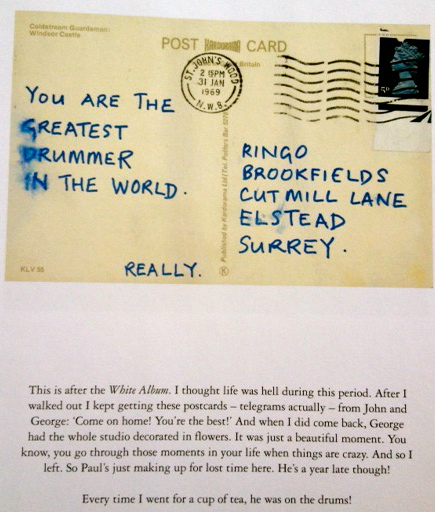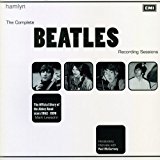Part of
"The Beatles" (aka the White Album) sessions
May 30 - Oct 18, 1968 • Songs recorded during this session appear on The Beatles (Mono)
- Album Songs recorded during this session officially appear on the The Beatles (Mono) LP.
- Studio:
- EMI Studios, Studio Two, Abbey Road
Timeline
More from year 1968
Some songs from this session appear on:
Spread the love! If you like what you are seeing, share it on social networks and let others know about The Paul McCartney Project.
About
On this day, The Beatles were at Abbey Road, to record Paul McCartney’s song “Back In The U.S.S.R.“. Ringo Starr became tired of Paul McCartney’s criticism of his drumming during the rehearsals for the song, and of the bad atmosphere of the White Album sessions generally. He decided to walk out of the session and leave the band.
I remember Ringo being uptight about something, I don’t remember what, and the next thing I was told was that he’d quit the band. But work continued. They did Back In The U.S.S.R. with what I seem to recall was a composite drum track of bits and pieces, possibly with all of the other three playing drums. Within a few days the differences had been sorted out and Ringo came back. Mal Evans completely decorated studio two with flowers, they were all over his drum kit, ‘Welcome Back Ringo’.
Engineer Ken Scott – from The Complete Beatles Recording Sessions, Mark Lewisohn
I’m sure it pissed Ringo off when he couldn’t quite get the drums to ‘Back In The USSR’ and I sat in. It’s very weird to know that you can do a thing someone else is having trouble with. If you go down and do it, just bluff right through it, you think, ‘What the hell, at least I’m helping.’ Then the paranoia comes in – ‘But I’m going to show him up!’ I was very sensitive to that.
Paul McCartney – 1986 interview – quoted in beatlesebooks.com
I think Ringo was always paranoid that he wasn’t a great drummer because he never used to solo. He hated those guys who went on and on, incessantly banging while the band goes off and has a cup of tea or something. Until Abbey Road, there was never a drum solo in The Beatles’ act, and consequently other drummers would say that although they liked his style, Ringo wasn’t technically a very good drummer. It was a bit condescending and I think we let it go too far.
I think his feel and soul and the way he was rock solid with his tempo was a great attribute. I always say if you can leave a drummer and turn your back on him, then you’re very lucky. You could just tell Ringo how it went and leave him — there was always this great noise and very steady tempo coming from behind you. Rock’n’roll is all about feel, really, and sound. So at that time, we had to reassure him that we did think he was great.
That’s what it’s like in life. You go through life and you never stop and say: ‘Hey, you know what? I think you’re great’. You don’t always tell your favourite drummer that he’s your favourite. Ringo felt insecure and he left, so we told him, ‘Look, man, you are the best drummer in the world for us.’ (I still think that.) He said ‘thank you’, and I think he was pleased to hear it. We ordered millions of flowers and there was a big celebration to welcome him back to the studio.
Paul McCartney – from the Beatles Anthology book
While we were recording the ‘White’ album we ended up being more of a band again, and that’s what I always love. I love being in a band. Of course, I must have moments of turmoil, because I left the group for a while that summer.
I left because I felt two things: I felt I wasn’t playing great, and I also felt that the other three were really happy and I was an outsider. I went to see John, who had been living in my apartment in Montagu Square with Yoko since he moved out of Kenwood. I said, ‘I’m leaving the group because I’m not playing well and I feel unloved and out of it, and you three are really close.’ And John said, ‘I thought it was you three!’
So then I went over to Paul’s and knocked on his door. I said the same thing: ‘I’m leaving the band. I feel you three guys are really close and I’m out of it.’ And Paul said, ‘I thought it was you three!’
I didn’t even bother going to George then. I said, ‘I’m going on holiday.’ I took the kids and we went to Sardinia.
Ringo Starr – from the Beatles Anthology book
In his 2003 book Postcards From The Boys, Ringo explained that his bandmates, especially Paul, loved playing the drums, which drove him mad.
Every time I went for a cup of tea, Paul was on the drums. I had three — three — frustrated drummers.’
Ringo Starr – from the book Postcards From The Boys, 2003

Ringo Starr would come back to the Beatles sessions on September 3.
Despite Ringo leaving the studio, the remaining Beatles decided to continue the work on “Back In The U.S.S.R.“. Five takes of the basic track were recorded, with Paul on drums, George Harrison on electric guitar, and John Lennon on bass. Take 5 was chosen as “best”.
Take 5 was released on the White Album’s 50th anniversary release in 2018.
The work on “Back In The U.S.S.R.” continued the day after, on August 23, 1968.
Last updated on September 19, 2021
Songs recorded
1.
2.
3.
4.
5.
Recording • Take 5
Album Officially released on The Beatles (50th anniversary boxset)
6.
Staff
Musicians on "Back In The U.S.S.R."
Production staff
Going further
The Complete Beatles Recording Sessions • Mark Lewisohn
The definitive guide for every Beatles recording sessions from 1962 to 1970.
We owe a lot to Mark Lewisohn for the creation of those session pages, but you really have to buy this book to get all the details - the number of takes for each song, who contributed what, a description of the context and how each session went, various photographies... And an introductory interview with Paul McCartney!
The fourth book of this critically acclaimed series, "The Beatles Recording Reference Manual: Volume 4: The Beatles through Yellow Submarine (1968 - early 1969)" captures The Beatles as they take the lessons of Sgt. Pepper forward with an ambitious double-album that is equally innovative and progressive. From the first take to the final remix, discover the making of the greatest recordings of all time. Through extensive, fully-documented research, these books fill an important gap left by all other Beatles books published to date and provide a unique view into the recordings of the world's most successful pop music act.
If we like to think, in all modesty, that the Paul McCartney Project is the best online ressource for everything Paul McCartney, The Beatles Bible is for sure the definitive online site focused on the Beatles. There are obviously some overlap in terms of content between the two sites, but also some major differences in terms of approach.




Contribute!
Have you spotted an error on the page? Do you want to suggest new content? Or do you simply want to leave a comment ? Please use the form below!